In Hawaiian mythology, an ʻaumakua is a personal or family god that originated as a deified ancestor, and which takes on physical forms such as spirit vehicles. An 'aumakua may manifest as a shark, owl, bird, octopus, or inanimate objects such as plants or rocks. The word ʻaumakua means ancestor gods and is derived from the Hawaiian words au which means period of time or era, and makua meaning parent, parent generation, or ancestor. Hawaiians believed that deceased family members would transform into ʻaumakua and watch over their descendants with a loving concern for them while also being the judge and jury of their actions.
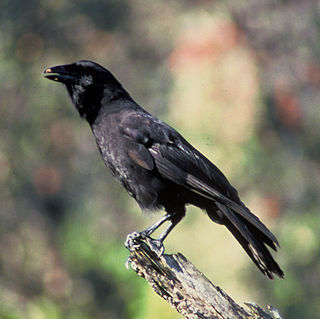
The Hawaiian crow or ʻalalā is a species of bird in the crow family, Corvidae, that is currently extinct in the wild, though reintroduction programs are underway. It is about the size of the carrion crow at 48–50 cm (19–20 in) in length, but with more rounded wings and a much thicker bill. It has soft, brownish-black plumage and long, bristly throat feathers; the feet, legs and bill are black. Today, the Hawaiian crow is considered the most endangered of the family Corvidae. They are recorded to have lived up to 18 years in the wild, and 28 years in captivity. Some Native Hawaiians consider the Hawaiian crow an ʻaumakua.
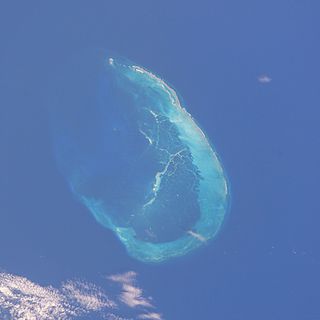
The French Frigate Shoals is the largest atoll in the Northwestern Hawaiian Islands. Its name commemorates French explorer Jean-François de La Pérouse, who nearly lost two frigates when attempting to navigate the shoals. It consists of a 20-mile-long (32 km) crescent-shaped reef, twelve sandbars, and the 120-foot-high (37 m) La Perouse Pinnacle, the only remnant of its volcanic origins. The total land area of the islets is 61.508 acres (24.891 ha). Total coral reef area of the shoals is over 232,000 acres (94,000 ha). Tern Island, with an area of 26.014 acres (10.527 ha), has a landing strip and permanent habitations for a small number of people. It is maintained as a field station in the Hawaiian Islands National Wildlife Refuge by the United States Fish and Wildlife Service. The French Frigate Shoals are about 487 nautical miles northwest of Honolulu.

The Amy B. H. Greenwell Ethnobotanical Garden is a Hawaiian botanical garden near Captain Cook, Hawaii in the Kona District on the Big Island of Hawaii. The gardens closed for the public on January 31, 2016. They are slated to re-open on February 29, 2020. The garden is now open to the public every Sunday from 9 am to 2 pm.

Octopus cyanea, also known as the big blue octopus or day octopus, is an octopus in the family Octopodidae. It occurs in both the Pacific and Indian Oceans, from Hawaii to the eastern coast of Africa. O. cyanea grows to 16 cm in mantle length with arms to at least 80 cm. This octopus was described initially by the British zoologist John Edward Gray in 1849; the type specimen was collected off Australia and is at the Natural History Museum in London.
Dracaena konaensis, synonym Pleomele hawaiiensis, the Hawaiʻi hala pepe, is a rare species of flowering plant that is endemic to the island of Hawaiʻi in the state of Hawaii.
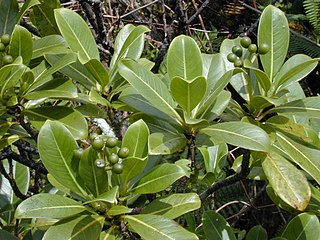
Psychotria mariniana, the forest wild coffee or kōpiko, is a tree endemic to Hawaiʻi. The plant belongs to the Rubiaceae (coffee) family, subfamily Rubioidae. It is a tree of varying size with a dark bark, shiny leaves, and orange oval fruit.

Ctenochaetus hawaiiensis are a species of reef surgeonfish in the family Acanthuridae. They were first described by ichthyologist John Ernest Randall in 1955.
Anisolabis hawaiiensis is a species of earwig in the genus Anisolabis, the family Anisolabididae, the suborder Forficulina, and the order Dermaptera. The species is native to Hawaii, and was first classified by Brindle in 1979.
Calliscelio is a parasitoid wasp monotypic genus which contains one species, C. elegans. It was first described as Caloteleia elegans on Oahu in the Hawaiian Islands in 1910 by British entomologist Robert Cyril Layton Perkins, who believed it not to be an indigenous species of Hawaii. Its pantropical species distribution is now well-established and it is still considered to be an adventive species in Hawaii. C. elegans was reassigned from its original genus to Caenoteleia in 1926 by French entomologist Jean-Jacques Kieffer and then to Calliscelio in 2009.

Callistoctopus ornatus is a tropical species of octopus native to the Indo-Pacific region. Other common names include white-striped octopus and night octopus, in reference to its nocturnal habits. It was previously known as Polypus ornatus. C. ornatus is edible and was recorded in a Hawaiian market in 1914 by S. S. Berry.

Spermolepis hawaiiensis is a rare species of flowering plant in the carrot family known by the common name Hawai'i scaleseed. It is endemic to Hawaii, where it is known from the islands of Kauai, Maui, Oahu, Molokai, Lanai, and Hawaii. It is threatened by the degradation of its habitat and it is a federally listed endangered species.
Koloonella is a genus of sea snails, marine gastropod mollusks in the family Murchisonellidae, the pyrams and their allies.
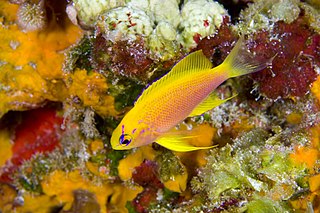
Pseudanthias hawaiiensis, the Hawaiian longfin anthias, is a small colorful species of fish in the subfamily Anthiinae. It is often treated as a subspecies of P. ventralis, but some authorities prefer to treat them as separate species. It is endemic to reefs at depths of 26–219 m (85–719 ft) in Hawaii and the Johnston Atoll.

The Hawaiian garden eel is an eel in the family Congridae. It was described by John Ernest Randall and James Robert Chess in 1980. It is a marine, tropical eel which is known from the Hawaiian archipelago, in the eastern central Pacific Ocean. It is non-migratory, and is thought to be restricted to the region. It dwells at a depth range of 11 to 53 metres, and leads a benthic life, forming burrows in sand. Males can reach a maximum standard length of 59.8 centimetres (23.5 in).
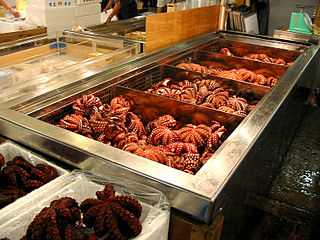
People of some cultures eat octopus. The arms and sometimes other body parts are prepared in various ways, often varying by species and/or geography.
Squalus hawaiiensis, the Hawaiian spurdog, is a dogfish, a member of the family Squalidae, found in waters surrounding the Hawaiian Islands, from the surface to 950 m. Its length is up to 75 cm.
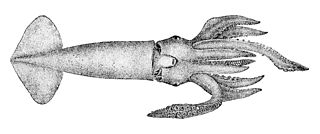
Nototodarus hawaiiensis, the Hawaiian flying squid, is a species of squid. It mainly lives at depths of about 400 - 570 m. It lives in the Pacific Ocean from Hawaiian Islands to Midway Island. It is listed as a Least Concern species by the IUCN red list.

The Hawaiian chub, also known as the insular rudderfish or bicolor chub, is a species of marine ray-finned fish, a sea chub belonging to the family Kyphosidae. This species is found in the Central Pacific Ocean.












